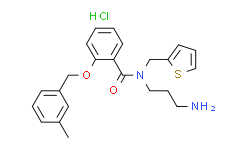| Cas No.: | 926023-82-7 |
| Chemical Name: | AMTB hydrochloride |
| Synonyms: | AMTB hydrochloride;N-(3-AMINOPROPYL)-2-[(3-METHYLPHENYL)METHOXY]-N-(2-THIENYLMETHYL)BENZAMIDE HYDROCHLORIDE |
| SMILES: | Cl.NCCCN(C(C1=CC=CC=C1OCC1=CC=CC=C1C)=O)CC1=CC=CS1 |
| Formula: | C23H27ClN2O2S |
| M.Wt: | 430.990683794022 |
| Purity: | >98% |
| Sotrage: | 2 years -20°C Powder, 2 weeks 4°C in DMSO, 6 months -80°C in DMSO |
| Description: | AMTB hydrochloride is a selective TRPM8 channel blocker. AMTB hydrochloride inhibits icilin-induced TRPM8 channel activation with a pIC50 of 6.23. AMTB hydrochloride can be used for the research of the overactive bladder and painful bladder syndrome. AMTB hydrochloride is a non-selective inhibitor of voltage-gated sodium channels (NaV)[1][2]. |
| In Vivo: | In the anesthetized rat, AMTB (3 mg/kg; intravenous) hydrochloride decreases the frequency of volume-induced bladder contractions, without reducing the amplitude of contraction[1]. |
| In Vitro: | AMTB hydrochloride blocks veratridine-induced membrane potential changes at each NaV1 isoform (pIC50s ranging 4.83-5.69 for NaV1.1- NaV1.8)[2]. AMTB hydrochloride decreases viable cell number in MDA-MB-231 and SK-BR-3 breast cancer cell lines (30 and 100 μM), and also reduces the migration of MDA-MB-231 cells (30 μM)[2]. |
| References: | [1]. Lashinger ES, et al. AMTB, a TRPM8 channel blocker: evidence in rats for activity in overactive bladder and painful bladder syndrome. Am J Physiol Renal Physiol. 2008;295(3):F803-F810. [2]. Yapa KTDS, et al. Assessment of the TRPM8 inhibitor AMTB in breast cancer cells and its identification as an inhibitor of voltage gated sodium channels. Life Sci. 2018;198:128-135. |

 To enhance service speed and avoid tariff delays, we've opened a US warehouse. All US orders ship directly from our US facility.
To enhance service speed and avoid tariff delays, we've opened a US warehouse. All US orders ship directly from our US facility.




















